Zotac's Ion: The World's First mini-ITX Ion Board
by Anand Lal Shimpi on May 12, 2009 12:00 AM EST- Posted in
- GPUs
Of all of the technologies VIA introduced over the years, I never expected a form factor to be its lasting legacy on the PC industry. The most ubiquitous of VIA’s technologies were its chipsets which are all but gone now - used only by VIA for the most part. VIA’s form factor however, lives on.
The form factor is ITX. Originally introduced by VIA to accompany its line of low-power microprocessors, long before Atom, ITX was designed to deliver much smaller computers than what was defined by the micro-ATX spec.
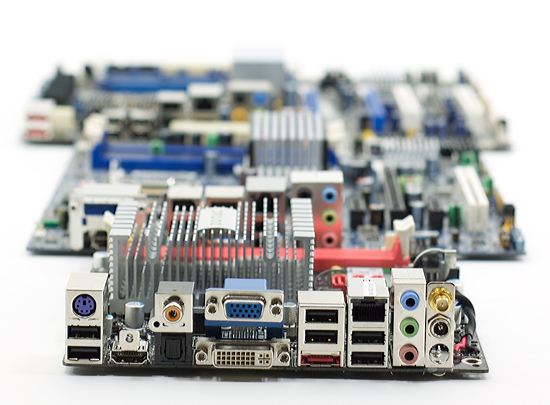
From front to back: Mini-ITX, micro-ATX, ATX
Intel was actually first to market a mini-ITX Atom based motherboard: the D945GCLF. Based on a single-core Atom 230 running at 1.6GHz, the D945GCLF is a relatively simple motherboard.
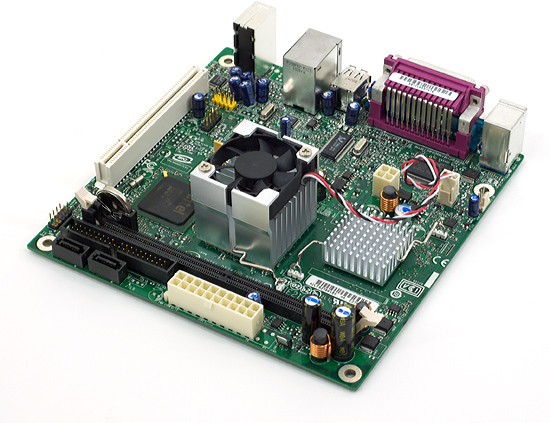
Intel's first desktop Atom board
It has a single DDR2 DIMM slot supporting up to 2GB of memory (DDR2-400 or 533 only). There’s no support for a modern day GPU, there’s only an old 32-bit PCI slot on the motherboard. You get two SATA and one PATA connector on board, four USB, no DVI/HDMI output (only VGA) and a standard set of three analog audio ports.
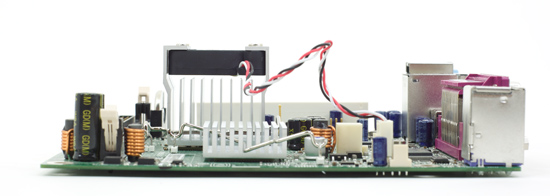
The tall heatsink in the back is for the chipset, the small one is all you need for the CPU

As its name implies the D945GCLF uses Intel’s 945G chipset and correspondingly slow graphics. However if you don’t need a ton of performance, Intel’s desktop Atom solution is quite attractive as it sells for under $70 - CPU included (it’s soldered onto the board).
With the quiet introduction of the dual-core Atom, Intel released the D945GCLF2. Nearly identical to its single core predecessor, the D945GCLF2 uses a larger heatsink on the CPU and a smaller one on the GMCH (although it is still cooled by a fan). The board also uses a 24-pin ATX power connector instead of a 20-pin connector, adds S-Video out and a Gigabit Ethernet port (the D945GCLF only has a 10/100 port).
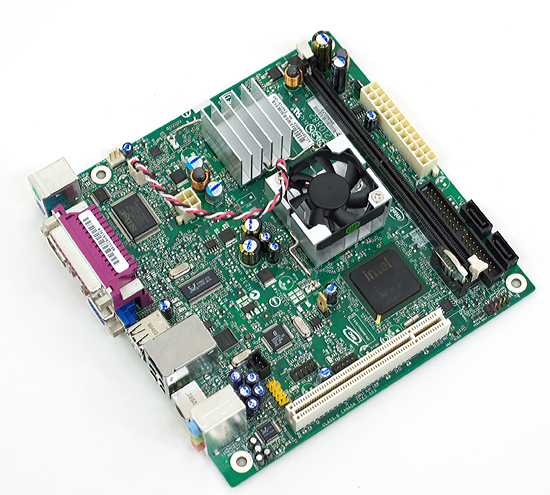
The dual core D945GCLF2 adds a second core to the Atom platform.

Bland ports on the D945GCLF2
The biggest difference is obviously the inclusion of the Atom 330 processor, which is simply two Atom 230 die on a single package - both running at 1.6GHz:
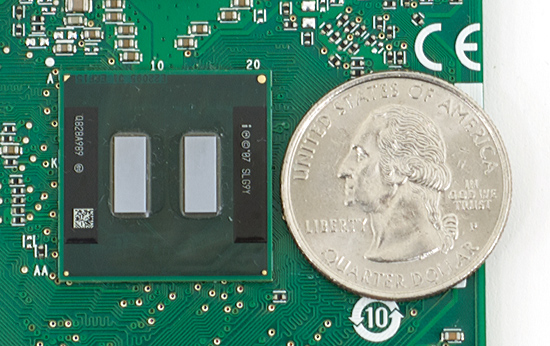
A dual core Atom 330
The faster CPU raises the total price up to $80, still very affordable.
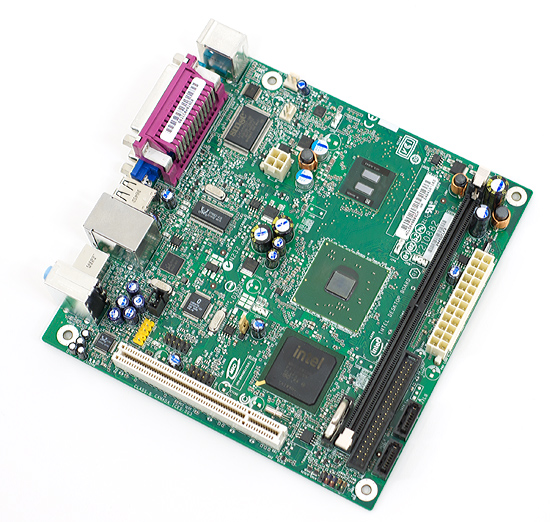
The 45nm Atom processor runs significantly cooler than the 945 GMCH on the board (center chip).
The Intel desktop Atom boards both work just fine but they’re a bit boring. They are reminiscent of Intel’s older motherboards, before it took competition from the tweakable Taiwanese motherboards seriously.
Zotac is the first manufacturer to produce a mini-ITX motherboard based on NVIDIA’s Ion platform. Take Intel’s Atom processor, pair it up with NVIDIA’s Ion chipset (which is basically a GeForce 9300 chipset) and you have the Ion platform.
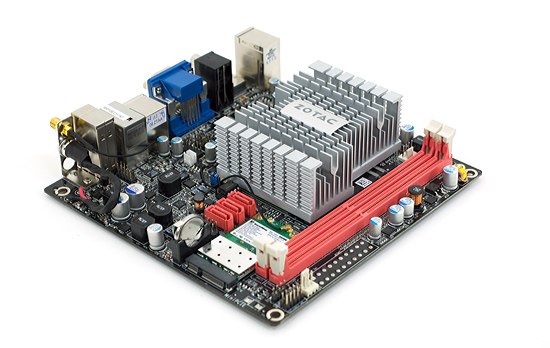










93 Comments
View All Comments
scottwilkins - Tuesday, May 19, 2009 - link
I need a ITX with PCI-e 1x slot. ANyone seen such an animal?dingetje - Tuesday, May 12, 2009 - link
@Pandamonium,No it was not rude; flipmode was obviously joking about the funny sounding line in the article.
Lighten up...
flipmode - Tuesday, May 12, 2009 - link
Yeah, it did sound pretty rude, but I was just giving him a hard time.Anand Lal Shimpi - Tuesday, May 12, 2009 - link
I didn't intend for the line to sound like that, I meant that after our first review went up there was a great amount of interest in an Ion motherboard from our readership. I'll update to clarify.I stuck with the x264 test for power consumption since we've used it in previous reviews and I needed a good way of comparing power consumption to other systems that can't play back Blu-ray content.
Take care,
Anand
flipmode - Tuesday, May 12, 2009 - link
I did not mean to sound too snotty, but I do enjoy being a smart ass once in a while. Maybe a :wink: would have been better than a :roll:As for power consumption, using x264 encoding does make sense for most reviews, but it seems a bit of stretch for this one. I sure do feel bad for anyone encoding x264 with an Atom. Do you think it is safe to say that the power consumption would be at its highest when the IGP is under load?
Anand Lal Shimpi - Tuesday, May 12, 2009 - link
I agree, in hindsight I should've probably done a load test with the GPU being stressed as well. I'll try and look at that if I do a followup.The power consumption of the Ion/GF9300 chipset should be higher than the dual-core Atom CPU, so anything that stresses the GPU should deliver the highest power consumption. Note that Blu-ray playback uses the PureVideo HD engine which is actually separate from the shader processors on the GPU, it's a separate set of functional blocks on the die. I wouldn't assume that BD playback would generate the highest power consumption values, playing a game might do the trick for that.
Take care,
Anand
yyrkoon - Wednesday, May 13, 2009 - link
Anand, Thanks much for the review. I have been wondering much about this platform since I first read the ads on nVidias webpages.Here, we live off grid, and are entirely powered by solar + wind (and the occasional running of a 30kW gen to pump water). What I was hoping to see here, was something that could play games fairly well at medium settings, do photoshop tasks fairly well, and play movies well also. I was fairly certain the latter would not be much of a problem, but the former two might have been. According to your benchmarks, it looks like my guess was not too far off.
Also, your review came about two days too late concerning a decisions I was making concerning getting a newer system for above duties, while keeping power usage down to a minimum. That however is not your fault, and probably made my decision much easier.
Now, I would like to add that the Zotac board with ATX power connectors is it ? May actually be a better overall option for some, including myself, *if* "we" can find a good sub 100W 80 Plus PSU. Once you get down to around 50-60W of system usage, the 50% PSU power out/usage combination is what can, and does kill power efficiency according to what I have been reading(e.g. for best efficiency, loading any PSU is usually optimal at 50% load capacity). George Oui from ZDNET tech articles (sorry may have spelled his last name incorrectly, I do not have the link handy) has done some experimentation on the subject, and at the time of his findings the best PSU he was able to find was the sparkle 220W 80 Plus PSU ( the PicoPSU's did not seem to do as well ). Anyways, he was able to get a complete Core 2 system, including an LCD monitor down to a sipping 49W of power usage while under load I believe. Personally, I consider that pretty good.
Anyways, thanks again, and I for one would love to see more articles along these lines.
Penti - Friday, May 29, 2009 - link
Why not simply run something downclocked? Low-power parts or simply a laptop with a discrete GPU is also a possibility. Or even something like the Fujitsu Amilo Sa 3650 with graphic booster (external mobile HD3870).BTW the Zotac board comes with a powersupply and doesn't have an ATX connector in this version Anand reviewed.
strikeback03 - Thursday, May 14, 2009 - link
The Pico-PSU efficiency is going to be rather dependent on the efficiency of your AC to DC conversion. They claim over 95% DC-DC efficiency, so if you have an efficient method of directly feeding them regulated 12V they probably do pretty well. I suppose if you needed multiple workstations you could use one ATX PSU to feed regulated 12V to a bunch of Pico-PSUs and get the load on the ATX PSU up to the range it likes. Otherwise, I'm not sure how efficient those bricks are at Ac to DC.therealnickdanger - Wednesday, May 13, 2009 - link
Great review, thanks!Speaking of GPU tests, I have seen other reviews of Ion showing Left 4 Dead playable at 25fps and WoW (720p, low details) playable at 50fps! How come your rates are so low?
I think it would be appropriate to follow up with testing of games like UT2004, Halo PC, COD4, Battlefield 2, and Counter-Strike: Source. Obviously, Crysis would be a waste of time on this platform, but some slightly older games that are still played heavily online and at LAN parties are ones I would really like to see benched.
Nothing would excite me more than to have a portable, cheap, fanless, low-power, Mini-ITX gaming machine for some of the games listed above. If it can manage 25-30fps at or near 720p without looking like a turd, that would be more than acceptable. Please don't make me buy one and benchmark it myself! ;-)